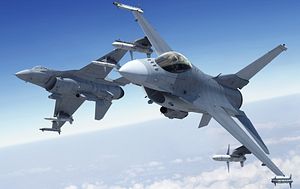Taiwan’s Ministry of National Defense is set to increase the budget for upgrading the Republic of China Air Force’s (ROCAF) fleet of 144 Lockheed Martin F-16 A/B Fighting Falcon combat aircraft, according to local media reports.
A defense ministry official who spoke on the condition of anonymity stated earlier this month that the F-16 budget will increase from NT$129.6 billion to NT$140.2 billion (US$4.21 billion to US$4.56 billion). Extra funds will primarily be allocated for purchasing additional air-to-air missiles for the fighter aircraft.
Taiwan’s F-16 fleet is equipped with the AIM-9 Sidewinder, a short-range air-to-air missile and the beyond-visual-range (BVR) AIM-120 Advanced Medium-Range Air-to-Air Missile, or AMRAAM. Of the latter, Taiwan has a stockpile of a little over 300, which yields a ratio of around 2 AMRAAMs per F-16.
Consequently, the ROCAF is primarily interested in procuring additional BVR air-to-air missile systems including more AIM-120s, but also domestically designed and produced alternatives such as the soon to be operationalized Sky Sword II medium-range air-to-air missile 空劍二飛彈 or Sky Sword.
The defense ministry has so far not publicly commented on the selection of the missiles. More details on the missile types and other aspects of the F-16 upgrade budget are expected to be made public following the review of the defense budget for fiscal year 2019 by the Legislative Yuan’s Foreign Affairs and National Defense Committee later this month.
Total cost for the upgrade of the 144 F-16s, known as the Phoenix Rising Project, is estimated at around $5.3 billion. All the aircraft will be upgraded to the latest F-16 configuration, dubbed V for “Viper.” The F-16s will be retrofitted with advanced avionics including a new flight management system, a new active electronically scanned array fire-control radar, an enhanced electronic warfare system, and helmet-mounted display system, next to others.
According to the Lockheed Martin website:
The core of the F-16V configuration is an Active Electronically Scanned Array (AESA) radar, a modern commercial off-the-shelf (COTS)-based avionics subsystem, a large-format, high-resolution display; and a high-volume, high-speed data bus. Operational capabilities are enhanced through a Link-16 Theater Data Link, Sniper Advanced Targeting Pod, advanced weapons, precision GPS navigation, and the Automatic Ground Collision Avoidance System (Auto GCAS).
Around 25 to 28 F-16 fighter jets will undergo modernization each year until 2023 at the state-owned Aerospace Industrial Development Corporation (AIDC), Lockheed Martin’s local partner in Taiwan, based in Taichung, while some fighter jets will also be flown to the United States to undergo upgrades.
The ROCAF has also repeatedly expressed its interest in procuring Lockheed Martin’s F-35-B Lightning II Joint Strike Fighter, the U.S. Marine Corps’ short take-off and vertical landing (STOVL) variant of the supersonic fifth-generation fighter jet.
However,“Taiwan’s defense needs would be better served if the government decides to invest additional resources into acquiring new highly mobile medium- and long-range surface-to-air missile (SAM) defense systems,” I noted last year. Taiwan’s fighter jets remain highly vulnerable to destruction on the ground by Chinese aircraft or missiles in the event of a conflict.
































